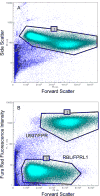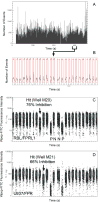High-content screening: flow cytometry analysis
- PMID: 19347622
- PMCID: PMC4476789
- DOI: 10.1007/978-1-60327-545-3_11
High-content screening: flow cytometry analysis
Abstract
The HyperCyt high-throughput (HT) flow cytometry sampling platform uses a peristaltic pump, in combination with an autosampler, and a novel approach to data collection, to circumvent time-delay bottlenecks of conventional flow cytometry. This approach also dramatically reduces the amount of sample aspirated for each analysis, typically requiring ~2 microL per sample while making quantitative fluorescence measurements of 40 or more samples per minute with thousands to tens of thousands of cells in each sample. Here, we describe a simple robust screening assay that exploits the high-content measurement capabilities of the flow cytometer to simicroltaneously probe the binding of test compounds to two different receptors in a common assay volume, a duplex assay format. The ability of the flow cytometer to distinguish cell-bound from free fluorophore is also exploited to eliminate wash steps during assay setup. HT flow cytometry with this assay has allowed efficient screening of tens of thousands of small molecules from the NIH Small-Molecule Repository to identify selective ligands for two related G-protein-coupled receptors, the formylpeptide receptor and formylpeptide receptor-like 1.
Figures




Similar articles
-
Duplex high-throughput flow cytometry screen identifies two novel formylpeptide receptor family probes.Cytometry A. 2009 Mar;75(3):253-63. doi: 10.1002/cyto.a.20645. Cytometry A. 2009. PMID: 18785269 Free PMC article.
-
High-throughput screening with HyperCyt flow cytometry to detect small molecule formylpeptide receptor ligands.J Biomol Screen. 2005 Jun;10(4):374-82. doi: 10.1177/1087057105274532. J Biomol Screen. 2005. PMID: 15964939
-
Biomolecular screening of formylpeptide receptor ligands with a sensitive, quantitative, high-throughput flow cytometry platform.Nat Protoc. 2006;1(1):59-66. doi: 10.1038/nprot.2006.9. Nat Protoc. 2006. PMID: 17406212
-
Flow Cytometry: Impact on Early Drug Discovery.J Biomol Screen. 2015 Jul;20(6):689-707. doi: 10.1177/1087057115578273. Epub 2015 Mar 24. J Biomol Screen. 2015. PMID: 25805180 Free PMC article. Review.
-
Flow cytometry for high-throughput, high-content screening.Curr Opin Chem Biol. 2004 Aug;8(4):392-8. doi: 10.1016/j.cbpa.2004.06.007. Curr Opin Chem Biol. 2004. PMID: 15288249 Review.
Cited by
-
Fluidics.Curr Protoc Cytom. 2013 Jul;Chapter 1:1.2.1-1.2.14. doi: 10.1002/0471142956.cy0102s65. Curr Protoc Cytom. 2013. PMID: 23835801 Free PMC article.
-
Essential Fluidics for a Flow Cytometer.Curr Protoc. 2024 Oct;4(10):e1124. doi: 10.1002/cpz1.1124. Curr Protoc. 2024. PMID: 39401000
-
A Selective Ligand for Estrogen Receptor Proteins Discriminates Rapid and Genomic Signaling.Cell Chem Biol. 2019 Dec 19;26(12):1692-1702.e5. doi: 10.1016/j.chembiol.2019.10.009. Epub 2019 Nov 6. Cell Chem Biol. 2019. PMID: 31706983 Free PMC article.
-
A Novel Flow Cytometric Assay to Identify Inhibitors of RBPJ-DNA Interactions.SLAS Discov. 2020 Sep;25(8):895-905. doi: 10.1177/2472555220932552. Epub 2020 Jun 22. SLAS Discov. 2020. PMID: 32567455 Free PMC article.
-
Facts and fiction: cellular models for high throughput screening for HIV-1 reactivating drugs.Curr HIV Res. 2011 Dec 1;9(8):568-78. doi: 10.2174/157016211798998826. Curr HIV Res. 2011. PMID: 22211661 Free PMC article. Review.
References
-
- Kuckuck FW, Edwards BS, Sklar LA. Cytometry. 2001;44:83–90. - PubMed
-
- Ramirez S, Aiken CT, Andrzejewski B, Sklar LA, Edwards BS. Cytometry. 2003;53A:55–65. - PubMed
-
- Young SM, Bologa C, Prossnitz E, Oprea TI, Sklar LA, Edwards BS. J Biomol Screen. 2004;10:374–382. - PubMed
-
- Edwards BS, Bologa C, Young SM, Balakin KV, Prossnitz E, Savchuck NP, Sklar LA, Oprea TI. Mol Pharmacol. 2005;68:1301–1310. - PubMed
-
- Edwards BS, Young SM, Oprea TI, Bologa C, Prossnitz E, Sklar LA. Nat Protocols. 2006;1:59–66. - PubMed
Publication types
MeSH terms
Substances
Grants and funding
LinkOut - more resources
Full Text Sources
Other Literature Sources

